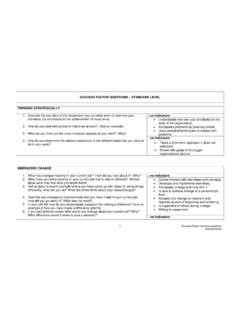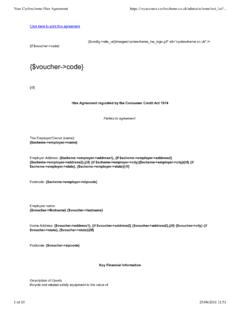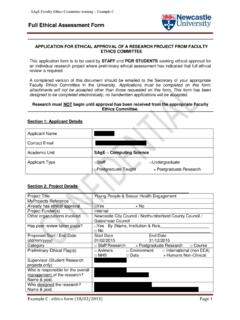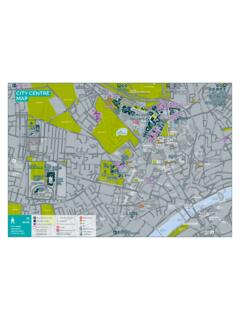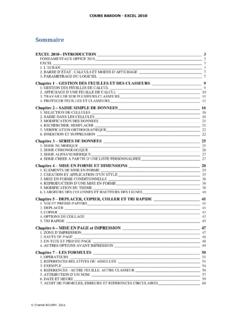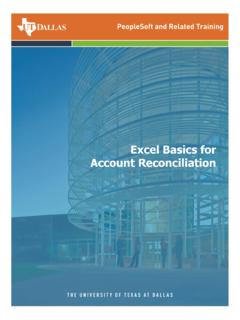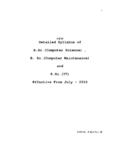Transcription of MS Excel 2010 - ncl.ac.uk
1 MS Excel 2010 Analysing Data Using Formulae & Pivot Tables User Guide NOMAS TRAINING & CONSULTANCY LTD Dissington Hall, Ponteland, Northumberland Tel : 01661 820 960 e-mail : Web : Because Training Matters CONTENTS INTRODUCTION .. 1 Moving Around Your Spreadsheet .. 2 CONDITIONAL FORMATTING .. 4 Setting A Conditional Format .. 4 Using Formulae As Conditions .. 6 Style Sets .. 7 Identifying All Cells With Conditional 8 Editing / Deleting Conditions .. 9 SORTING AND FILTERING DATA .. 10 Sorting A List By A Single Column .. 10 Sorting A List By Multiple Columns .. 10 Sorting A List By Colour .. 12 Filter A List .. 14 Filter A List Using AutoFilter .. 15 RE-ORGANISING DOWNLOADED 17 Converting Text To Columns Parsing 17 Removing Spaces.
2 20 Removing Non-Printing Characters .. 20 CALCULATIONS USING FORMULAE .. 21 Creating A Simple Formula .. 22 Formulae Involving Cell References .. 22 Addition Of Columns Or Rows .. 23 Copying Formulae Relative & Absolute References .. 23 Formulae Using Functions .. 25 Using IF Statements .. 26 Using VLOOKUP .. 27 Conditional Sums .. 30 Extracting Data from the Left or Right of a Cell .. 32 Combining Cell Content .. 33 PIVOT TABLE .. 34 What Is A Pivot Table ? .. 34 The Pivot Table Wizard .. 35 Creating Pivot Filters .. 38 Changing Date Grouping .. 39 Adding Sub Totals .. 39 Re-Designing A Pivot Table .. 41 Drilling Down Into The Data In A Pivot Table .. 41 Slicers .. 42 Create A Slicer In An Existing Pivot Table .. 42 Format A Slicer .. 43 Delete A Slicer.
3 44 Updating A Pivot Table .. 44 Creating A Chart From A Pivot Table .. 44 Re-Organising The Pivot Table .. 45 Adding Columns And Rows .. 45 Removing Columns And Rows .. 45 Changing The Summary Functions .. 46 Hiding / Displaying Sub & Grand Totals .. 47 APPENDIX 1 - FUNCTION KEYS .. 48 Function Keys .. 48 CTRL Combination Shortcut Keys .. 50 Other Useful Shortcut Keys .. 53 Nomas Training & Consultancy Ltd Excel 2010 Analysing Data Using Formulae & Pivot Tables Page 1 INTRODUCTION This guide covers the analysis of data using formulae, functions & pivot tables, within Excel 2010 . To obtain maximum benefit from attending this training session, you should have attended an introductory course or be an existing user of Excel . At the end of this course, each delegate will have an understanding of several key functions used in data analysis & will be able to create formulae, use functions, sort & filter data & analyse data using pivot tables.
4 COPYRIGHT Nomas Training & Consultancy Ltd 2014 This manual should not be copied or reproduced in any way, nor its contents used for any purpose, which has not been specifically granted by Nomas Training & Consultancy Ltd. Nomas Training & Consultancy Ltd Excel 2010 Analysing Data Using Formulae & Pivot Tables Page 2 Moving Around Your Spreadsheet A spreadsheet is made up of a matrix of columns and rows, into which text, dates and numbers can be entered. Excel contains ; 16,384 Columns. 1,048,576 Rows. When working in your spreadsheet you can move around by use of both the mouse and the keyboard. You can also move around the spreadsheet using the scroll bars or by using the following keyboard strokes ; Moving On A Sheet Arrow Keys Move up/down/left/right as required.
5 Page Up/Page Down Moves one screen up or down. Tab / Shift + Tab Moves one cell left or right. F5 Moves to the cell number that you enter. Ctrl + Home Moves to cell A1. Ctrl + Left Arrow Moves to the cell furthest to the left hand of the spreadsheet that contains data. Ctrl + Right Arrow Moves to the cell furthest to the right hand of the spreadsheet that contains data. Ctrl + Up Arrow Moves to the cell furthest to the top of the spreadsheet that contains data. Ctrl + Down Arrow Moves to the cell furthest to the bottom of the spreadsheet that contains data. Selecting Cells Shift + Left / Right Arrow Keys Selects cells one at a time to the left / right. Shift + Up / Down Arrow Keys Selects cells one at a time up / down. Ctrl + Shift + Left / Right Arrow Keys Selects cells to the end of a block of data in a row.
6 Ctrl + Shift + Up / Down Arrow Keys Selects cells to the end of a block of data in a column. Nomas Training & Consultancy Ltd Excel 2010 Analysing Data Using Formulae & Pivot Tables Page 3 Moving Between Worksheets Ctrl + Page Up Moves to the previous Worksheet. Ctrl + Page Down Moves to the next Worksheet. Right Click Mouse Over Sheet Navigation Arrows Adding A New Worksheet Click Insert Worksheet icon (circled) Nomas Training & Consultancy Ltd Excel 2010 Analysing Data Using Formulae & Pivot Tables Page 4 CONDITIONAL FORMATTING Excel can be used to highlight data that meets conditions that you specify. To highlight formula results or other cell values that you want to monitor, you can identify the cells by applying Conditional Formats.
7 Setting A Conditional Format For instance, in an Orders data set, Excel can apply red shading to the cell, if the Total Price is greater than 1,000 or blue shading if the Total Price is less than 1,000. To apply conditional formats to cells ; 1 Select the cells you want to format. In this example, select the Total Order cells only. 2 Select Conditional Formatting from the Home tab. 3 Select Highlight Cell Rules . 4 Then select an appropriate option Greater Nomas Training & Consultancy Ltd Excel 2010 Analysing Data Using Formulae & Pivot Tables Page 5 5 Enter the amount in the first dialogue box & then select the drop down option in the second dialogue box, to set the appropriate formatting options.
8 Use Custom Format if you want to set your own formatting options. 6 Select the font style, font colour, underlining, borders, shading, or patterns you want to apply. 7 To add another condition, repeat the steps above. 8 To review the conditional formats applied to the cells, use Conditional Rules from the Home tab. 9 Here you can create new rules or modify / delete existing rules. Nomas Training & Consultancy Ltd Excel 2010 Analysing Data Using Formulae & Pivot Tables Page 6 Using Formulae As Conditions In the previous example, the cell colour in a single column (Total Order) was changed. In order to apply the cell colour all the way across a row, then a formula could be used. 1 Select the cells you want to format (the whole data set).
9 2 Select Conditional Rule from the Home tab. 3 Select Use a formula to determine which cells to format . 4 Enter a suitable formula & format for the cells & click OK . 5 In this example, the formula would be =$I2 > 1000. Nomas Training & Consultancy Ltd Excel 2010 Analysing Data Using Formulae & Pivot Tables Page 7 Style Sets Data Bars, Colour Scales & Icon Sets can also be used to format cells. In the example below, Total Prices can be marked with Traffic Lights to indicate whether the Total is less than 250, between 250 - 1,000 or over 1,000. Nomas Training & Consultancy Ltd Excel 2010 Analysing Data Using Formulae & Pivot Tables Page 8 Identifying All Cells With Conditional Formatting If your worksheet has one or more cells with a conditional format, you can quickly locate them so that you can change or delete the conditional formats.
10 You can use the Go To Special command, to either find only cells with a specific conditional format or find all cells with conditional formats. 1 Click any cell without a conditional format. 2 In the Home tab, click the drop down arrow under Find & Select . 3 Select Conditional Formatting . 4 Any Conditionally formatted cells will be selected. Nomas Training & Consultancy Ltd Excel 2010 Analysing Data Using Formulae & Pivot Tables Page 9 Editing / Deleting Conditions To delete a condition ; 1 Select your Conditionally Formatted cells. 2 Select Conditional Rules from the Home tab. 3 Select the format to delete & click Delete Rule . 4 Edit a Conditional Format, in the same manner, by clicking Edit Rule . Nomas Training & Consultancy Ltd Excel 2010 Analysing Data Using Formulae & Pivot Tables Page 10 SORTING AND FILTERING DATA Sorting A List By A Single Column To sort data in ascending / descending order based on values in a single column ; 1 Click a cell in the column you want to sort.
